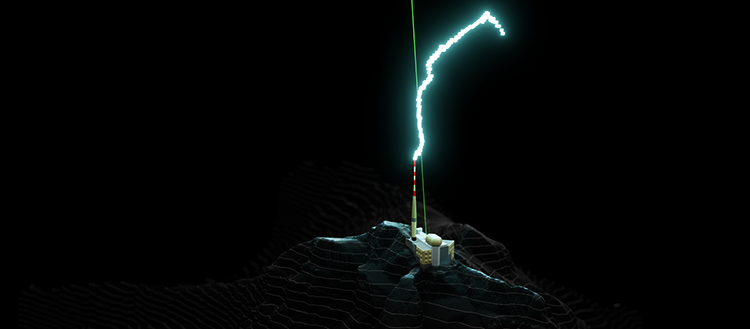A European consortium headed by the University of Geneva (UNIGE), École Polytechnique (Paris), EPFL, hes-so, and TRUMPF has managed to direct lightning by making use of a high-power laser installed at the top of Mount Säntis, located in Switzerland.

In tests conducted on the summit of the Säntis, the scientists found that the discharge could follow the laser beam for several dozen meters before reaching the tower of the operator Swisscom. Image Credit: © Xavier Ravinet-University of Geneva.
Power cuts, forest fires, damaged infrastructure, etc. are caused by lightning, leading to as many as 24,000 deaths annually and extensive damage. As of today, the lightning rod fabricated by Benjamin Franklin is known to be the best safety measure.
Despite that, these rods do not frequently offer improved safety for sensitive sites. A European consortium comprised of the University of Geneva (UNIGE), École Polytechnique (Paris), EPFL, hes-so, and TRUMPF scientific lasers (Munich) has come up with a new alternative: the Laser Lightning Rod or LLR.
Following the testing of LLR on the summit of Säntis (in Switzerland), scientists now have evidence of its potential. The rod has the power to deflect lightning over several dozen meters, even in bad weather.
The study outcomes have been reported in the Nature Photonics journal.
Lightning is known to be one of the most extreme natural phenomena. A sudden electrostatic discharge of millions of volts and hundreds of thousands of amperes, lightning can occur in a single cloud, between several clouds, between a cloud and the ground, and vice-versa.
When very high power laser pulses are emitted into the atmosphere, filaments of very intense light form inside the beam. These filaments ionize the nitrogen and oxygen molecules in the air, which then release electrons that are free to move. This ionized air, called ‘plasma’, becomes an electrical conductor.
Jean-Pierre Wolf, Study Last Author and Full Professor, Department of Applied Physics in the Physics Section, Faculty of Science, University of Geneva
Tests at an Altitude of 2,500 m
The LLR project meant that a new laser had to be developed with an average power of 1 KW, one Joule per pulse, and a duration per pulse of one picosecond. The rod measures a width of 1.5 m, a length of 8 m, and weighs over 3 tons, and it was developed by TRUMPF scientific lasers.
The testing of this terawatt laser was done on the summit of Säntis (in Appenzell, at a height of 2,502 m), which has been used already by EPFL and HEIG-VD/HES-SO to monitor lightning. It was attached to a 124-m transmitter tower belonging to the telecommunications provider Swisscom. This was fitted with a conventional lightning rod, as it is one of the structures that has been highly affected by lightning in Europe.
“The main difficulty was that it was a life-size campaign. We had to prepare an environment in which we could install and protect the laser,” states Pierre Walch, a Ph.D. student in the Laboratoire d’Optique Appliquée (LOA), a collaborative research unit CNRS, École Polytechnique, ENSTA Paris, Institut Polytechnique de Paris, Palaiseau, France.
The laser was triggered every time storm activity was predicted between June and September 2021. The area had to be shut down to air traffic beforehand.
The aim was to see whether there was a difference with or without the laser. We compared the data collected when the laser filament was produced above the tower and when the tower was struck naturally by lightning.
Aurélien Houard, Project Coordinator and Research Scientist, Laboratoire d’Optique Appliquée, University of Geneva
Effective Even Through Cloud
It took nearly a year to examine the colossal amount of data that was gathered. Currently, the analysis shows that the LLR laser could guide lightning in an effective manner. Professor Wolf additionally explains:
From the first lightning event using the laser, we found that the discharge could follow the beam for nearly 60 meters before reaching the tower, meaning that it increased the radius of the protection surface from 120 m to 180 m.
Jean-Pierre Wolf, Study Last Author and Full Professor, Department of Applied Physics in the Physics Section, Faculty of Science, University of Geneva
The data analysis also illustrates that the LLR, unlike other lasers, functions even in harsh weather conditions—like fog (frequently found at the summit of Säntis)—as it pierces through clouds.
Previously, this result had only been achieved in the lab. The following step for the consortium will be to raise the height of the laser’s action even more. The long-lasting objective includes utilizing the LLR to expand a 10 m lightning rod by 500 m.
Journal Reference
Houard, A., et al. (2022) Laser-guided lightning. Nature Photonics. doi.org/10.1038/s41566-022-01139-z.